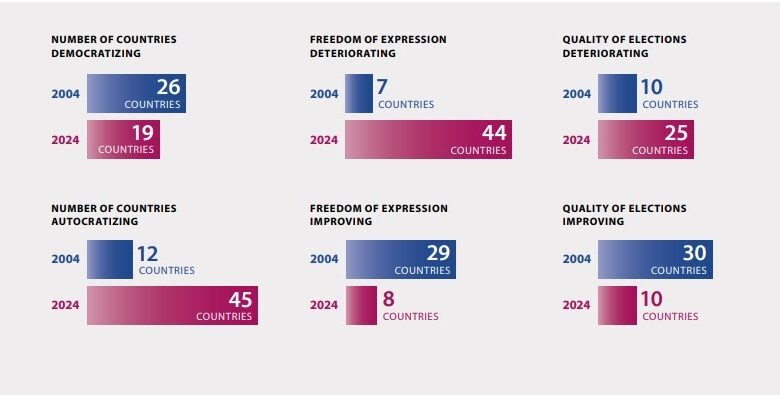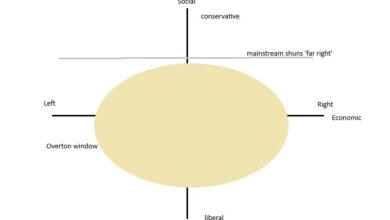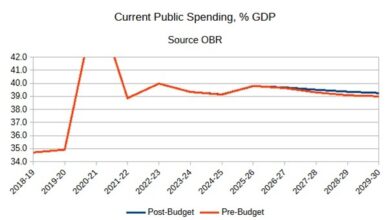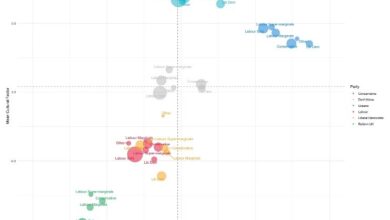
From 2025
V-DEM report
In global terms
autocracies are on the rise, and democracies are declining. According
to the V-Dem
Institute, for the first time in more than 20 years,
the world has fewer
democracies than autocracies. Other
estimates point to the same trend. At a global level
there are obviously many reasons why this is happening, but in
Western countries one stands out: the rise of right wing populism.
In many of the major
economies, the main political divide is increasingly between one or
more right wing populist parties and more mainstream parties of the
centre or left. Of course from year to year political popularity can
be volatile, but the trend is also unmistakable. This
is happening either because of the growing popularity of an insurgent
populist party (Rassemblement National and Reconquête in France, AFD
in Germany, Fratelli d’Italia in Italy and Reform in the UK) or the
transition of a mainstream party of the right into a populist party
(the Republican party in the US and the Conservatives in the UK).
Of course democracy
can survive the election of a right wing populist party into
government. There are plenty of examples of where it has (Trump’s
first term as POTUS, Poland and the UK, for example). But the nature
of right wing populism also means that there is a significant chance
it may not. Populism is about a political party proclaiming that it
alone represents ‘the people’, and that other parties or
institutions represent ‘elites’ that work against the people. As
a result, populist right wing governments tend to dismantle the key
elements of a pluralistic democracy, such as an independent media,
judiciary and civil service. They are autocratic, usually placing an
unprecedented amount of power in one individual’s hands. In those
circumstances, elections can easily cease to be fair, such that a
democracy is effectively replaced with an autocracy.
If the key electoral
contest in most major countries is between right wing populism and
more mainstream parties, then right wing populists are likely to win
at least some of these contests. If that sometimes leads to the end
of democracy, or steadily erodes the possibility of fair elections,
then unless autocracies collapse into democracies at an equal rate
the number of democracies will steadily decline and the number of
autocratic governments will increase. This process will be
accelerated if autocracies intervene in other democracies to support
right wing populism, as Russia has been doing and as Trump has
started to do.
Why are right wing
populist parties growing in popularity? This is an issue that I have
discussed many times, most recently here.
I think it is helpful to make a distinction between what some (not
just economists) describe as the demand and supply sides. The supply
side relates to politicians, the media and money: why for example
mainstream politicians may choose to adopt populist policies, or why
billionaires may fund populist politicians or parties. In the past I
have talked about why right wing parties wanting to push unpopular
neoliberal ideas might choose to focus on more social issues like
immigration. The demand side is about why right wing populism is
increasingly attractive to some voters. It is the latter I want to
focus on in this post.
It is familiar
territory that the politics of class, that used to be the central
divide in most major economies, has and perhaps still is being
gradually replaced by divisions between social liberals and social
conservatives. Of course economic issues remain very important in
elections, but increasingly the settled patterns in voting behaviour
are not related to class but rather to age and education. Socially
conservative voters tend to be older, and socially liberal voters are
more likely to have been to university. A central issue that divides
liberals from conservatives and which is becoming more and more
important in elections is immigration.
To look at why this
is happening we can focus on either the declining importance of
class-based economic issues, or the growing importance of
predominantly social issues like immigration. On the first, the
decline in manufacturing employment in most major economies and its
replacement by service sector jobs is part of the story. [1] This is
one reason for the declining influence of trade unions. In the UK I
think the triumph of Thatcherism and the end of incomes policies was
more important. You can also add into the mix the decline in the
Soviet Union as an alternative to capitalism.
Immigration has
become more important as an issue in part because there is more of
it. Immigration has
been on the rise in all regions, and pretty well all
countries within any region. However it is far too crude to suggest
that higher numbers automatically generate higher concern. Worries
about immigration are often greatest in areas where immigration is
relatively low and vice versa: London relative to other areas in the
UK is an
obvious example. A much more important determinant of
attitudes to immigration is where people are situated on the social
liberalism/conservatism spectrum (e.g. here).
Key determinants of
where people are on this spectrum are age and education. Two general
trends in most societies have amplified these divisions. First, over
the last fifty years more people have received a university
education, and this
increases the extent of socially liberal views. As graduates tend to form most of the political and broadcast media elites, this
may be one reason why social attitudes have become increasingly
liberal in most countries since WWII, although with the rise in right
wing populism this trend may be ending or even reversing. .
Second, the number
of older people has been steadily rising because of medical and other
advances. A crude measure of this is the old age dependency ratio,
which divides the number of people 65 or older by the number of
people of roughly working age (20-64). In 1960, the dependency
ratio for the OECD as a whole was 16%, but by 2020 it
had doubled to 30%. By 2075 this ratio is expected to be nearly 60%.
This means that a growing proportion of voters are no longer in work,
so work-based economic issues will have less salience, although this
effect is moderated to a minor degree by any increases in the retirement
age. In addition, older people are more likely to vote. All this
creates a growing pool of socially conservative voters which
politicians can appeal to.
While these trends
may help explain the growing importance of social and cultural issues
in elections, we need an additional step to explain why political
parties that aim to attract socially conservative voters are also
likely to be populist and autocratic. Socially conservative views
tend to go with authoritarian opinions:
social scientists often refer to the social conservative/liberal axis
as the authoritarian/liberal axis. Authoritarian views will generate
an impatience with independent sources of power (or
indeed democracy itself).
It also means that socially conservative voters are more likely to be
attracted by ‘strong’ (charismatic) leaders, of a type that generally lead populist parties.
All
this is a very broad brush account, and please tell me of any
important demand side factors I have ignored. But to
the extent that it is valid, it suggests that the factors that have created a growing demand for socially conservative populism, and further down the line the trend away from democracy, are unlikely to be reversed anytime soon.
[1] An alternative
story about the rise in populism focuses on those ‘left behind’
by this and other aspects of globalisation. This economic mechanism
appears very different from the social/cultural discussion that I
focus on. These two alternative perspectives regularly compete when
right wing populism triumphs. When Trump was first elected, for
example, there was plenty of debate between those who wanted to
essentially blame racist attitudes among the white majority and those
who wanted to look at the left behind in once prosperous industrial
states. Brexit saw similar discussions. Exactly the same tension can
be seen in
discussions about Poland’s recent presidential
election.
I have taken a
similar line to Dani
Rodrick on this, which is that this tension can be at
least partially resolved by distinguishing between levels and
changes. Social/cultural issues provide the bedrock of support for
right wing populists, but it is often economic issues that can tip
the balance between these populists winning or losing electoral
races. As this post is about the steady rise in right wing populism,
rather than why right wing populists sometimes win, I naturally focus
on social/cultural explanations.
Source link





